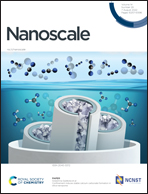Surface potential-determined performance of Ti3C2T2 (T = O, F, OH) and Zr3C2T2 (T = O, F, OH, S) MXenes as anode materials of sodium ion batteries†
Abstract
Sodium ion batteries (SIBs) have attracted increasing attention due to their low cost and abundant reserves of sodium, but their ideal anode materials still need to be explored. MXenes could be candidate electrode materials due to their excellent electrical conductivity and large specific surface area. In this work, the theoretical performance of Ti- and Zr-containing MXenes Ti3C2T2 (T = O, F, OH) and Zr3C2T2 (T = O, F, OH, S) as SIB anode materials is investigated. The influence of the Hubbard U correction is discussed, and the behaviour at the MXene surface with the partial occupation of sodium atoms is considered. Including the weight and volume of adsorbed sodium atoms, Ti3C2O2 presents the best performance among the seven MXenes studied. Its mass and volumetric capacities are 299 mA h g−1 and 993 mA h cm−3 respectively, and the migration barrier and open circuit voltage are 0.138 eV and 0.421 V. Both Zr3C2O2 and Zr3C2S2 can adsorb double layers of sodium atoms on both sides, and the former shows a higher capacity because of its lower weight and smaller volume. The mass and volumetric capacities of Zr3C2O2 are 254 mA h g−1 and 913 mA h cm−3 respectively. More importantly, the surface potential is determined to be an effective descriptor for selecting electrode materials. The migration barrier is proportional to the fluctuation amplitude of the surface potential. A low surface potential generally implies a high capacity. A large open circuit voltage is prone to appear in the structure with a large fluctuation amplitude and a low average value of its surface potential.



 Please wait while we load your content...
Please wait while we load your content...